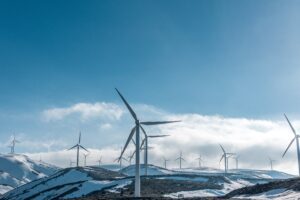Alberta 
Wind and solar: A robust forecast for renewable energy in Alberta
 The Alberta government’s target to eliminate coal-powered electricity is expected to be achieved seven years ahead of its scheduled date of 2030. The Alberta Electric System Operator says of all the electricity generated in the province in 2020, 14 per cent came from renewable energy sources, such as wind, hydro and solar. The number for 2021 is expected in the next few months. The province’s total capacity of renewable energy sources is 23 per cent. RBC predicts that investment in Alberta’s renewable energy sector will continue to grow. It points to the Travers Solar Project currently under construction in Vulcan County, southeast of Calgary. The project includes more than one million solar panels that will generate enough electricity to power 150,000 homes. The RBC report says there are 61 solar projects underway in the province that are expected to be completed by the middle of this decade. Source: CBC News
The Alberta government’s target to eliminate coal-powered electricity is expected to be achieved seven years ahead of its scheduled date of 2030. The Alberta Electric System Operator says of all the electricity generated in the province in 2020, 14 per cent came from renewable energy sources, such as wind, hydro and solar. The number for 2021 is expected in the next few months. The province’s total capacity of renewable energy sources is 23 per cent. RBC predicts that investment in Alberta’s renewable energy sector will continue to grow. It points to the Travers Solar Project currently under construction in Vulcan County, southeast of Calgary. The project includes more than one million solar panels that will generate enough electricity to power 150,000 homes. The RBC report says there are 61 solar projects underway in the province that are expected to be completed by the middle of this decade. Source: CBC News
Electricity Prices for Alberta
The Alberta power pool price averaged 12.627 cents per kWh in December 2021. This price is 2.714 cents higher than last month’s average. The pool price has averaged 10.237 cents per kWh over the last 12 months.
As of January 7, 2022, the forward market was predicting electricity prices for the calendar years of 2022, 2023, 2024, 2025, 2026, and 2027. These prices are 9.400, 7.000, 6.200, 5.900, 5.900, and 5.900 cents per kWh respectively.
Gas Prices for Alberta
Direct Energy’s gas rate for December 2021 was $4.936 per GJ in Alberta. The January 2022 rate has been set at $3.893 per GJ. Alberta gas prices have averaged $3.680 per GJ over the last 12 months.
As of January 7, 2022, the forward market was predicting gas prices for the calendar years of 2022, 2023, 2024, 2025, 2026, and 2027. These prices are 3.48, 3.13, 3.02, 3.05, 3.13, and 3.19 cents per GJ respectively.
British Columbia 
Here are 7 things experts say could make B.C.’s cities more climate-proof
B.C. saw numerous climate disasters, including heat waves, wildfires, and floods in 2021. After a year of cascading climate disasters in the province, experts are calling on B.C.’s provincial government and other authorities to shore up long-term housing and urban design strategies to make sure they are climate-resilient. Marc Lee, an analyst with the Canadian Centre for Policy Alternatives, said the province’s housing stock consists largely of detached homes located far from job sites. Lee said the province should focus on non-market housing and encourage local governments to rezone land so as many as six homes could be built on a single lot. There is also an important social element to building more densely: connecting vulnerable seniors to young people in times of emergency. The province should mobilize emergency shelters ahead of time if extreme weather is forecast, and make sure those who need shelter from the cold or heat are getting it. The number of trees growing in a city — known as the tree canopy — should also be a priority for city planners. Instead of focusing on air conditioners during extreme heat events, Boston says homeowners should focus on insulation and cross-ventilation in their homes. Source: CBC News
Ontario 
Home energy audit program added at reThink Green in Sudbury due to high demand
 ReThink Green, the non-profit organization in Sudbury, Ont., is getting in on the high demand for home energy audits. The agency has hired a home energy auditor and will launch a corresponding program later this month. ReThink Green’s other program, Green Economy North, works with businesses and municipalities in the northeast to help them find ways to reduce carbon emissions and find energy efficiencies. Georges said it only made sense to create a similar program for personal homes. The cost for a home energy audit depends on the size of the home, and rebates could range from $400 to $5,000, depending on where the grant is coming from, and what retrofits the homeowner may have made. Source: CBC News
ReThink Green, the non-profit organization in Sudbury, Ont., is getting in on the high demand for home energy audits. The agency has hired a home energy auditor and will launch a corresponding program later this month. ReThink Green’s other program, Green Economy North, works with businesses and municipalities in the northeast to help them find ways to reduce carbon emissions and find energy efficiencies. Georges said it only made sense to create a similar program for personal homes. The cost for a home energy audit depends on the size of the home, and rebates could range from $400 to $5,000, depending on where the grant is coming from, and what retrofits the homeowner may have made. Source: CBC News
Electricity Prices for Ontario
The Hourly Ontario Energy Price (HOEP) was an average of 3.462 cents per kWh in December 2021. This price is 0.474 cents lower than last month’s 3.936 cents per kWh. The twelve month moving average was 2.678 cents per kWh up to December 2021.
The Actual Rate for the Global Adjustment rate Class B for November 2021 was set at 5.417 cents per kWh. The Global Adjustment is an additional charge paid by non-regulated customers. (Source: IESO)
Saskatchewan 
Icy Sask. temperatures prompt record demand for natural gas
Provincial demand for natural gas has broken the daily record for the third time in a span of about a week and a half, with help from the extremely cold temperatures across Saskatchewan. SaskEnergy estimates the province used about 1.66 petajoules (PJ) on Thursday, surpassing the previous record set on Dec. 29 of 1.64 PJ. SaskEnergy uses petajoules — equal to one million gigajoules — to measure natural gas consumption. An average home in the province uses about 100 gigajoules of natural gas every year. This is the ninth winter in a row that the daily usage record has been either matched or exceeded. SaskEnergy is encouraging residents to conserve energy and reduce heating bills by changing the furnace filter every month or two to increase efficiency, lowering the house temperature at night or when not at home and washing clothes in cold water. Source: CBC News
Manitoba 
Manitoba Hydro electricity rates going up 3.6% starting in new year
The Public Utilities Board, which oversees utilities, approved a 3.6 per cent interim rate increase beginning Jan. 1, 2022. The increase expires Nov. 15, 2022, barring a subsequent successful rate hike application by Manitoba Hydro. Manitoba Hydro’s wish for a five per cent electricity rate increase did not come true this year. There will be no increase to the rates for certain customer classes in the diesel zone (a group of four northern communities that rely on diesel-generated electricity supplied by Manitoba Hydro, according to the PUB) or to Surplus Energy Program rates. Source: CBC News
New Brunswick 
Indigenous communities along Atlantic coast at risk from rising sea levels
 First Nations communities along the Atlantic coast may face grave challenges from climate change, a recent federal report says. Tom Johnson, the Geographic Information Systems co-ordinator at Mi’gmawe’l Tplu’taqnn Incorporated, was one of the writers on the report. Johnson helped map out New Brunswick for the report. He said the loss of land from coastal erosion is minor for most communities but Ugpi’ganjig, a coastal community situated along the Eel River and the Bay of Chaleur, is at higher risk. A dam built in the 1960s caused changes in sediment distribution, destroying sandbars, and increased erosion led to the loss of 24 hectares of land, which in turn increased the community’s flood risk. The report said there are plans to increase flood preparedness in Indigenous communities like improving drainage systems, and raising and fixing flood damaged homes and other infrastructure. Source: CBC News
First Nations communities along the Atlantic coast may face grave challenges from climate change, a recent federal report says. Tom Johnson, the Geographic Information Systems co-ordinator at Mi’gmawe’l Tplu’taqnn Incorporated, was one of the writers on the report. Johnson helped map out New Brunswick for the report. He said the loss of land from coastal erosion is minor for most communities but Ugpi’ganjig, a coastal community situated along the Eel River and the Bay of Chaleur, is at higher risk. A dam built in the 1960s caused changes in sediment distribution, destroying sandbars, and increased erosion led to the loss of 24 hectares of land, which in turn increased the community’s flood risk. The report said there are plans to increase flood preparedness in Indigenous communities like improving drainage systems, and raising and fixing flood damaged homes and other infrastructure. Source: CBC News
Prince Edward Island 
Milk bags better for the environment than jugs, carton containers, study finds
Milk bags are the most environmentally friendly form of milk packaging there is, according to a new study by a chemistry professor from Dalhousie University. The study says “pillow pouches,” as they’re known in the industry, use less energy and water for production, transportation and disposal than plastic jugs or cartons, and also cause less greenhouse emissions. Compared to jugs and cartons, bags use 20 to 30 per cent less energy, and produce 20 to 40 per cent fewer greenhouse gases. They also use about two per cent of the water cartons require, and 40 per cent relative to jugs. Source: CBC News
Québec 
The construction sector produces almost a third of Quebec landfill waste. This machine could change that
Tommy Bouillon, the president of Maçonnerie Gratton, worked on the research and development of the Brique-Recyc machine for three years. It allows workers to clean bricks on site so they can be reused. Year after year, bricks represented almost 41 per cent of all the company’s waste — and often the bricks could have been recycled, said Bouillon. “There’s a ton of undamaged bricks that are thrown away every year because it costs less to send a brick to a landfill than to recycle them, which is nonsense in a world where we tend toward a circular economy.” Bouillon said reports done with Synergie Montréal showed recycling the materials from just one 100-square-metre wall can eliminate the equivalent of a car and a half’s yearly carbon footprint. Maçonnerie Gratton works on 500 sites per year, which, when recycled, is about 750 cars off the road. “On top of saving tons of CO2 every year, it’s also economically advantageous for our clients. There’s no reason not to use this machine,” said Bouillon. The next step is commercializing the machine. Source: CBC News
Newfoundland and Labrador 
50 years of Churchill Falls: Marking a reluctant milestone
One of the largest engineering projects in Canadian history, Churchill Falls was completed 18 months ahead of schedule, producing its first power on the evening of Dec. 6, 1971. As one of the largest underground power generating projects in the world, the Churchill Falls site produces 34 terawatt hours of energy per year — roughly one per cent of the world’s hydroelectric power, according to Nalcor’s website. The project provides Hydro-Quebec with about 13 per cent of its power. The $1-billion deal struck between CFLCo and Quebec’s crown energy company, which sees it drawing energy at a cost of less than half a cent per kilowatt-hour, has been a source of contention between the two provinces since it was signed in 1969. At the time, three mills — or three tenths of a cent — was the going price for hydroelectricity. But when that price surged in the early 1970s, so did Hydro-Quebec’s profits, prompting then-premier Frank Moores to claim the project was “the biggest giveaway in history.” Attempts to renegotiate the terms of the 65-year contract since then have proven fruitless. Source: CBC News
Nova Scotia 
Why Nova Scotia’s fossil fuel energy megaprojects are going bust
 Several of Nova Scotia’s energy megaprojects have fizzled in recent months and years, and some say the societal shift toward renewables is the reason. AltaGas, the company with a plan to store up to 10 billion cubic feet of natural gas in underground caverns, announced in October it was pulling the plug on the project due to the “repositioning of the business and the challenging nature of the storage project economics.” The future of the Bear Head LNG project, a proposal to bring in natural gas to Port Hawkesbury from Western Canada or the U.S., and then export it to Europe, is uncertain after the company behind the project tried to sell it last year. The province’s offshore oil and gas future looks less than rosy after a call for exploration bids this year yielded no interest. In October 2021, the Nova Scotia government tabled legislation that would see coal-fired electricity generation phased out and 80 per cent of the province’s power coming from renewables by 2030. Nova Scotia Power president Peter Gregg said the utility expects to meet the 80 per cent target largely through two renewable megaprojects, the Maritime Link and the Atlantic Loop. Source: CBC News
Several of Nova Scotia’s energy megaprojects have fizzled in recent months and years, and some say the societal shift toward renewables is the reason. AltaGas, the company with a plan to store up to 10 billion cubic feet of natural gas in underground caverns, announced in October it was pulling the plug on the project due to the “repositioning of the business and the challenging nature of the storage project economics.” The future of the Bear Head LNG project, a proposal to bring in natural gas to Port Hawkesbury from Western Canada or the U.S., and then export it to Europe, is uncertain after the company behind the project tried to sell it last year. The province’s offshore oil and gas future looks less than rosy after a call for exploration bids this year yielded no interest. In October 2021, the Nova Scotia government tabled legislation that would see coal-fired electricity generation phased out and 80 per cent of the province’s power coming from renewables by 2030. Nova Scotia Power president Peter Gregg said the utility expects to meet the 80 per cent target largely through two renewable megaprojects, the Maritime Link and the Atlantic Loop. Source: CBC News
Nunavut 
New power plant in Arctic Bay up and running
The Qulliq Energy Corporation has completed the construction and testing of a new power plant in Arctic Bay. The $32.4-million plant replaces the 45-year-old system in Arctic Bay, one of the oldest in the territory. It that had outlived its life expectancy, QEC said. The news release states the new plant is equipped with energy-efficient generator sets that will reduce the company’s consumption of diesel fuel. Rick Hunt, QEC president and CEO, said in the release that the new power plant has been relocated outside the community, in collaboration with the hamlet. Source: Nunatsiaq News
Northwest Territories 
Need a home energy audit in the N.W.T.? That’ll take ‘at least’ a year
The Arctic Energy Alliance (AEA) has moved money around to address a backlog of people waiting for energy efficiency rebates in the N.W.T. — but if you’re looking for a home energy audit, that’ll take more than a year. The audits are carried out by AEA-certified evaluators, and are designed to help people understand how their home uses energy and what improvements can be made to make it more energy efficient. Mark Heyck, the alliance’s executive director, said the evaluations have been put on hold a few times because of the evolving COVID-19 situation in the territory. A backlog created by those pauses has been compounded by a spike in interest in audits after the federal government announced a new rebate program last year that requires them. Heyck said the organization would be able to address all the people who were still waiting for their electric vehicle rebate in the current fiscal year, and now has the capacity to process a few more applicants before it ends on March 31, 2022, as well. Source: CBC News
Yukon 
Active transportation dominates budget input session
Delegates are calling on the City of Whitehorse to invest more in infrastructure for active transportation. It’s a move, they argued, that would result in fewer vehicles on the road, less spending on roads and has the potential to help improve the health of citizens. Nathan Miller, for example, highlighted a number of areas where there are no sidewalks. He also questioned whether the city has the equipment to maintain active transportation networks like trails and encouraged the city to extend the lower escarpment trail. “I think it’s probably one of the principal ways that the city can help address climate change actions,” he said, after also encouraging council to move forward quickly with initiatives that could provide more housing and to work on prioritizing infrastructure projects in the city’s core. Source: Yukon News